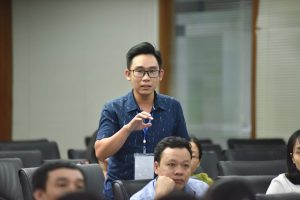 Hey, Guys!
Hey, Guys!
My name is Minh Nguyen-Quang and I am Vietnamese. I have been working on optimizing plasma configurations at Laboratoire de Catalyse & Spectroscopie (LCS), ENSICAEN – CNRS under supervision of Assoc.Prof.Dr. FEDERICO Azzolina-Jury as the first stage of my PhD timeline. My secondment would be in AGH University of Science and Technology which is located in Kraków, Poland with the instruction of co-supervisor, Professor. Monika MOTAK.
Looking back to the past, I accomplished my bachelor’s degree in 2017 at Hanoi University of Science and Technology, school of Chemical engineering. My background is GTL process in which majorly focus on the conversion of gases into hydrocarbons in the presence of catalysts. Then, I had a chance studying in Germany as a Master student at amazing Leibniz-Institut für Katalyse e.V. laboratory; that was an incredibly memorable experience. We successfully modified catalyst for DeNOx reaction via discrepancy of catalytic synthesis methods.
Moving to the new Plasma-catalysis field is not only great chance to broaden my horizons but also the biggest challenge to prove myself. It would be amazing if I can contribute my tiny research to the big picture of globally sustainable development as well as plasma field.
This is an absolutely great opportunity for me as well as the 14 others, I believe, to become PhD in PIONEER project. I would like to give my thanks to the European commission, the MSCA and PIONEER project and all great supervisors for this reason.
| Overview |  |
| ESR: | 6 |
| Title: | Efficient catalysts preparation for plasma-assisted CO2 methanation |
| Home Institution: | Laboratoire de Catalyse & Spectroscopie (CNRS – LCS) |
| 1st Supervisor: | Federico Azzolina-Jury |
| Host Institution: | AGH University of Science and Technology (AGH-UST) |
| 2nd Supervisor: | Monika Motak |
| Secondment: | Sorbonne University (SU) |
| Defence: | May 2 2023 |
Abstract
In terms of sustainable development, efforts are made not just to reduce CO2 and other greenhouse gas (GHG) emissions but also to employ renewable energy sources rather than fossil fuels. As a result of such prerequisites, one of the primary solutions is considered to be the combination of low energy content molecules, such as CO2, and higher energy degree molecules, including H2, produced through the use of renewable energy resources, to produce added-valued compounds with higher thermodynamic energy.
From a technological standpoint, the science and technology revolution enables the use of plasma, namely non-thermal plasma (NTP), in chemical processes. Due to their light mass, given electrical energy in a gas-plasma will preferentially heat electrons (a few eV, a few 10000 K) without heating the entire gas (even at ambient temperature to a maximum of about 1000 K). These energetic electrons will then collide with gas molecules, producing excited species, ions, radicals, and so on. Under moderate temperatures, these species quickly interact, resulting in the formation of new molecules.
The combination of these directions offers a promising direction known as plasma-assisted CO2 methanation (Sabatier reaction), which targets CH4 since it can be easily stored in the existing gas network or used as feedstock for the production of highly added-valuable chemicals.
CO2 dissociation in plasma will be studied as the first phase toward understanding CO2 conversion. Following CO2 methanation (phase 2) – the goal is to find an efficient catalyst capable of operating both in thermal and plasma regimes. This PhD thesis is, therefore, a multidisciplinary study.
In terms of CO2 dissociation, we will present the findings in various cylindrical DBD reactors to investigate the effect of reaction parameters and reactor topologies on overall CO2 splitting into CO. The parameters will be examined, including outer electrode designs (Cu tube, Ag-Cu wire, and Cu screw coil), dielectric layer thickness, frequency, applied voltages, catalyst size and shape, total flowrate, and CO2 concentrations.
In the second phase, the first step is to test NiMgAl-hydrotalcite-induced mixed oxides catalysts (Ni-HiMO) for CO2 methanation among alumina and SBA-15. The activity will be briefly examined in order to select the catalyst for future investigation.
We will concentrate on the synthesis techniques (coprecipitation, impregnation, urea hydrolysis) of Ni-HiMO for thermal methanation (TM) tests in the second step. The catalyst activation time under thermal conditions is also examined at this step. These data will be utilized to identify the optimal synthesis method and conditions for further studies.
Third, after choosing Ni-HiMO and the coprecipitation method, we will present a novel approach to catalyst modification using the surfactant pluronic P123 at different concentrations (Ni-HiMO-P123). This effort will allow for the development of a novel technology to alter Ni-HiMO catalysts in terms of structure, morphology, and activity enhancement without using a second metal in both thermal and plasma methanation (TM and PM).
To complete the second phase, the promotional effects of 10 promoters into Ni-HiMO-P123 catalysts will be investigated, including transition group (Mn, Fe, Co, Cu), rare-earth and lanthanoid elements (Sc, Y, La, Gd), and alkaline elements (Ca, Ba). The complete package of physicochemical, electrical, and plasma parameters correlated with thermal and plasma behaviors will be reviewed. In both cases, the prevailing factor will be highlighted. Also covered will be the synergy between catalysts and plasma.
Finally, the reaction mechanism will be explored via Operando experiments in thermal and plasma circumstances (TO and PO), as well as the stability of intermediate species using in-situ FTIR measurements. We look forward to serving with the shift toward a more sustainable future!
Links with other ESR
- ESR 1, 2, 5 and 13: Influence of the layered support materials on plasma development
- ESRs 7-10: Direct comparison of material efficiency

